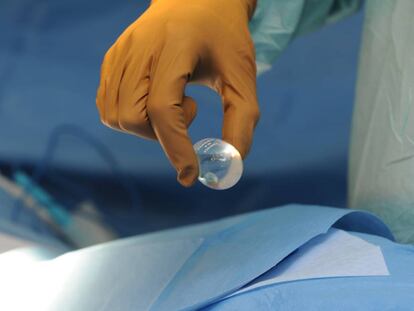What is hypogonadism and how do you know if you have it?
This condition occurs when the testes do not produce normal levels of testosterone

The most important male sex hormone is testosterone. Testosterone plays a key role in a man's growth and development during puberty and also regulates sex drive, bone mass, fat distribution, muscle mass and strength, and the production of red blood cells and sperm. However, some men can develop a condition called male hypogonadism. Male hypogonadism is when the testes, also called the testicles, do not produce normal levels of testosterone. Men can be born with the condition or develop it later in life.
The definitive way to diagnose male hypogonadism is with a blood test
When a boy enters puberty, the pituitary gland releases luteinizing hormone (LH), which stimulates the testicles to produce testosterone. Testosterone is responsible for developing the male characteristics in adolescent boys. Another hormone, called the follicle stimulating hormone (FSH), works along with LH to stimulate the production of sperm in the testicles.
Signs of male hypogonadism
A variety of symptoms and signs can indicate male hypogonadism. These include:
- Reduced libido or sexual interest
- Fewer spontaneous night-time and morning erections
- Incomplete sexual development
- Reduced growth of facial hair
- Fatigue and loss of energy
- Very small or shrinking testes
- Breast enlargement
- Reduced muscle mass and strength
- Mild depression
- Reduced sperm production causing infertility
- Osteoporosis
Confirming male hypogonadism
The definitive way to diagnose male hypogonadism is with a blood tests that measures whether testosterone levels are in the normal range. A man usually needs to have more than one early morning blood test to check his testosterone levels. What is considered normal range may vary depending on the laboratory, but it is generally considered to be 300 to 1,000 ng/dl. If the tests show repeatedly low testosterone levels, then another test must be done to measure the LH and FSH levels in the pituitary gland.
Causes of male hypogonadism
There may be several reasons why a man has male hypogonadism. One is what is called primary hypogonadism. This means the testes are not working properly, a problem that could be caused by the following:
- Klinefelter’s syndrome
- Improper development of the testes
- Undescended testes – the testes are located in the body instead of in the scrotum
- Damage to the testes from an infection, disease or injury
- Surgical removal of the testes
- Radiation or chemotherapy to the testes
Men can be born with the hypgonadism or develop it later in life
Secondary hypogonadism occurs when the endocrine glands are not stimulating the testes to produce testosterone. This can be caused by:
- Radiation treatments for cancer
- Certain medication such as opiates and replacement hormones
- Damage to the pituitary or hypothalamus glands
- Hemochromatosis – excess iron in the blood
- Genetic conditions such as Kallmann syndrome and Prader-Willi syndrome
Treating male hypogonadism
The most common treatment for men with consistently low testosterone levels and symptoms of androgen deficiency is testosterone replacement therapy. The goal of testosterone replacement therapy is to increase testosterone levels.
This treatment is not suitable for men with active or a history of prostate cancer, untreated obstructive sleep apnea, uncontrolled severe heart failure or those with a severe enlargement of the prostate that causes difficulty in urinating.
Testosterone can be replaced in the following ways:
- Injections into the muscle – usually every two weeks
- Patches applied to the skin once a day
- Gel or solution applied once a day
- Buccal tablets applied to the gums twice a day
- Pellets implanted under the skin
- Pills
The best option depends on the patient's preference, tolerance, cost, and what is covered by their medical insurance. Each option has different side effects. Injections for instance may be uncomfortable, skin patches cause redness and rashes while gels can transfer testosterone to other people who come into contact with the skin where the medication is applied.
All men using testosterone replacement therapy must be regularly monitored by his physician for the duration of the treatment.
Dr. Samadi is a board-certified urologic oncologist trained in open and traditional and laparoscopic surgery and is an expert in robotic prostate surgery at Lenox Hill Hospital. He is a medical correspondent for the Fox News Channel's Medical A-Team Learn more at roboticoncology.com. Visit Dr. Samadi's blog at SamadiMD.com. Follow Dr. Samadi on Twitter, Instagram, Pinterest and Facebook.
Tu suscripción se está usando en otro dispositivo
¿Quieres añadir otro usuario a tu suscripción?
Si continúas leyendo en este dispositivo, no se podrá leer en el otro.
FlechaTu suscripción se está usando en otro dispositivo y solo puedes acceder a EL PAÍS desde un dispositivo a la vez.
Si quieres compartir tu cuenta, cambia tu suscripción a la modalidad Premium, así podrás añadir otro usuario. Cada uno accederá con su propia cuenta de email, lo que os permitirá personalizar vuestra experiencia en EL PAÍS.
¿Tienes una suscripción de empresa? Accede aquí para contratar más cuentas.
En el caso de no saber quién está usando tu cuenta, te recomendamos cambiar tu contraseña aquí.
Si decides continuar compartiendo tu cuenta, este mensaje se mostrará en tu dispositivo y en el de la otra persona que está usando tu cuenta de forma indefinida, afectando a tu experiencia de lectura. Puedes consultar aquí los términos y condiciones de la suscripción digital.






























































